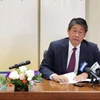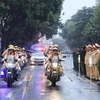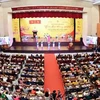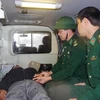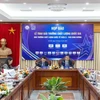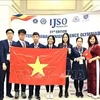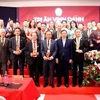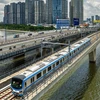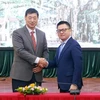Truong Son range is likened to the backbone of the inseparable Vietnam–Laos body. Among the mountains is Truong Son trail, better known as Ho Chi Minh trail, which is a deep and evergreen manifestation of the fighting alliance and solidarity between the two countries. An insight by the Nhan Dan (People) online newspaper.
The name of the Ho Chi Minh trail, which runs through the Truong Son range, was given by soldiers in several provinces of central and southeast inter-regions during the national resistance war against the French colonialists.
At first, it was a north-south communication route following the primitive footpaths of ethnic minority groups living in Truong Son range. When the US imperialists conducted invasion war of Vietnam’s southern region, the Vietnamese Party directed the restoration and reinforcement of the route as a transportation system that supplied manpower and materiel to the southern battlefield.
A special military mission, known as Army Corps 559 – Truong Son soldiers, was officially established on May 19, 1959 to shoulder the task of opening the route.
As the terrain of the mountain range’s eastern side was particularly rough and the area had been heavily raided by the enemy, a strategic transportation route was planned in the western side of the mountain.
Under the motto of “split Truong Son mountain range to save the nation” and "fight the enemy to travel, build roads to advance” raised by the soldiers, the route was quickly lengthened to Vietnam’s border areas with Laos’ Attapeu province and with Cambodia’s northeast area. It also went further to Vietnam’s Central Highlands and Southeast regions.
The trail served as a strategic transportation route to supply men and materials to the front line, contributing to the victory of the Indochinese people.
Over one decade from its operation to the signing of the Paris Agreement in 1973, the trail suffered nearly four million tonnes of bombs, which means that every kilometer of the trial incurred around 735 bombs in various types; millions of gallons of toxic chemical which exterminated to the every root of the forests; over 100 encroaching operations and more than 1,000 raids conducted by the enemy.
The US Air Force launched thousands of bombardments against 180 villages of Lao ethnic minority groups living along the trail, setting fire to 845 homes, killing 482 people and injuring 344.
Not submitting the enemy’s brutal attacks, Lao ethnic people in 17 villages and districts along the strategic transportation route in the western Truong Son were resilient to maintain the toehold, collaborate with Lao patriotic armed forces and Vietnamese soldiers to fight against the air force, prevent the enemy’s encroaching and destructive operations and protect the trail.
All Vietnamese soldiers, youth volunteers and workers who directly participated in making the trail and fighting in the western Truong Son, were sheltered and supported wholeheartedly as Lao people’s family members.
The strategic trail helped transport 1.5 million tonnes of goods, 5.5 million tonnes of petroleum, over 1.1 million officials and soldiers and a large volume of modern weapons to the south and fronts.
For both countries’ people, it can be affirmed that the strategic transportation route has been the way to the victory against the US imperialism to liberate the country.
The trail’s establishment and development is a vivid symbol for the special relationship between Vietnam and Laos and for the unity of the three Indochinese countries of Vietnam, Laos and Cambodia in the national salvation fight against the US imperialism.
It was created on firm natural socio-geographical factors and vital objective requirements of the fight to protect independence and freedom, as well as to contribute to national construction of each nation.
The legendary path is resulted from a self-conscious revolutionary process in a principle of equality, solidarity, mutual interests and respect of each other’s independence and sovereignty.
Vietnam is grateful the Lao People's Revolutionary Party and Lao people for the route maintenance to help educate younger generations about history.-VNA
The name of the Ho Chi Minh trail, which runs through the Truong Son range, was given by soldiers in several provinces of central and southeast inter-regions during the national resistance war against the French colonialists.
At first, it was a north-south communication route following the primitive footpaths of ethnic minority groups living in Truong Son range. When the US imperialists conducted invasion war of Vietnam’s southern region, the Vietnamese Party directed the restoration and reinforcement of the route as a transportation system that supplied manpower and materiel to the southern battlefield.
A special military mission, known as Army Corps 559 – Truong Son soldiers, was officially established on May 19, 1959 to shoulder the task of opening the route.
As the terrain of the mountain range’s eastern side was particularly rough and the area had been heavily raided by the enemy, a strategic transportation route was planned in the western side of the mountain.
Under the motto of “split Truong Son mountain range to save the nation” and "fight the enemy to travel, build roads to advance” raised by the soldiers, the route was quickly lengthened to Vietnam’s border areas with Laos’ Attapeu province and with Cambodia’s northeast area. It also went further to Vietnam’s Central Highlands and Southeast regions.
The trail served as a strategic transportation route to supply men and materials to the front line, contributing to the victory of the Indochinese people.
Over one decade from its operation to the signing of the Paris Agreement in 1973, the trail suffered nearly four million tonnes of bombs, which means that every kilometer of the trial incurred around 735 bombs in various types; millions of gallons of toxic chemical which exterminated to the every root of the forests; over 100 encroaching operations and more than 1,000 raids conducted by the enemy.
The US Air Force launched thousands of bombardments against 180 villages of Lao ethnic minority groups living along the trail, setting fire to 845 homes, killing 482 people and injuring 344.
Not submitting the enemy’s brutal attacks, Lao ethnic people in 17 villages and districts along the strategic transportation route in the western Truong Son were resilient to maintain the toehold, collaborate with Lao patriotic armed forces and Vietnamese soldiers to fight against the air force, prevent the enemy’s encroaching and destructive operations and protect the trail.
All Vietnamese soldiers, youth volunteers and workers who directly participated in making the trail and fighting in the western Truong Son, were sheltered and supported wholeheartedly as Lao people’s family members.
The strategic trail helped transport 1.5 million tonnes of goods, 5.5 million tonnes of petroleum, over 1.1 million officials and soldiers and a large volume of modern weapons to the south and fronts.
For both countries’ people, it can be affirmed that the strategic transportation route has been the way to the victory against the US imperialism to liberate the country.
The trail’s establishment and development is a vivid symbol for the special relationship between Vietnam and Laos and for the unity of the three Indochinese countries of Vietnam, Laos and Cambodia in the national salvation fight against the US imperialism.
It was created on firm natural socio-geographical factors and vital objective requirements of the fight to protect independence and freedom, as well as to contribute to national construction of each nation.
The legendary path is resulted from a self-conscious revolutionary process in a principle of equality, solidarity, mutual interests and respect of each other’s independence and sovereignty.
Vietnam is grateful the Lao People's Revolutionary Party and Lao people for the route maintenance to help educate younger generations about history.-VNA

